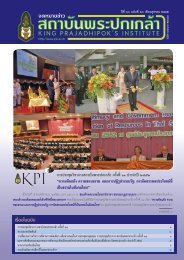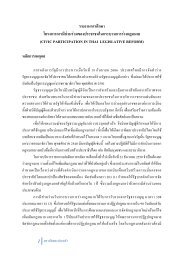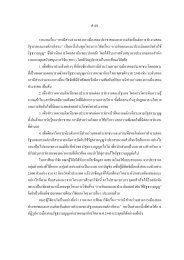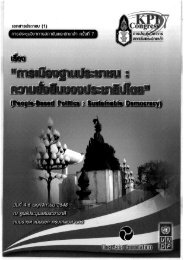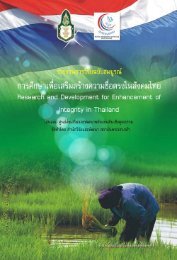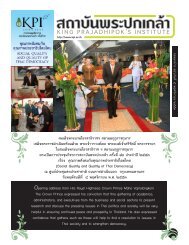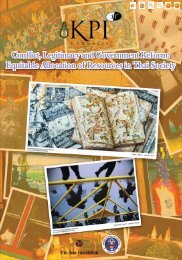SUFFiciENcy EcONOMy ANd GRASSROOtS DEvElOPMENt
SUFFiciENcy EcONOMy ANd GRASSROOtS DEvElOPMENt
SUFFiciENcy EcONOMy ANd GRASSROOtS DEvElOPMENt
You also want an ePaper? Increase the reach of your titles
YUMPU automatically turns print PDFs into web optimized ePapers that Google loves.
The Meaning of Sufficiency Economy <br />
International Conference<br />
283<br />
In India, various estimates put the requirements of micro credit at Rs. 150<br />
billion to Rs. 500 billion per year. As against these estimates, bank advances to<br />
weaker section aggregated about Rs. 100 billion per year and SHGs are estimated<br />
to provide about 1 billion per year. About 36 per cent of the rural households are<br />
outside the fold of institutional credit.<br />
The post-nationalization period in the banking sector, circa 1969, witnessed a<br />
substantial amount of resources being earmarked towards meeting the credit needs<br />
of the poor. There were several objectives for the bank nationalization strategy<br />
including expanding the outreach of financial services to neglected sectors (Singh,<br />
2005). As a result of this strategy, the banking network underwent an expansion<br />
phase without comparable in the world. Credit came to be recognized as a remedy<br />
for many of the ills of the poverty. There spawned several pro-poor financial<br />
services, support by both the State and Central governments, which included credit<br />
packages and programs customized to the perceived needs of the poor. While the<br />
objectives were laudable and substantial progress was achieved, credit flow to the<br />
poor, and especially to poor women, remained low. This led to initiatives that were<br />
institution driven that attempted to converge the existing strengths of rural banking<br />
infrastructure and leverage this to better serve the poor. The pioneering efforts at this<br />
were made by National Bank for Agriculture and Rural Development (NABARD),<br />
which was given the tasks of framing appropriate policy for rural credit, provision of<br />
technical assistance backed liquidity support to banks, supervision of rural credit<br />
institutions and other development initiatives.<br />
In the early 1980s, the GOI launched the Integrated Rural Development<br />
Program (IRDP), a large poverty alleviation credit program, which provided<br />
government subsidized credit through banks to the poor. It was aimed that the poor<br />
would be able to use the inexpensive credit to finance themselves over the poverty<br />
line. Also during this time, NABARD conducted a series of research studies<br />
independently and in association with MYRADA, a leading non-governmental<br />
organization (NGO) from Southern India, which showed that despite having a wide<br />
network of rural bank branches servicing the rural poor, a very large number of the<br />
poorest of the poor continued to remain outside the fold of the formal banking<br />
system. These studies also showed that the existing banking policies, systems and<br />
procedures, and deposit and loan products were perhaps not well suited to meet the<br />
most immediate needs of the poor. It also appeared that what the poor really needed<br />
was better access to these services and products, rather than cheap subsidized credit.<br />
Against this background, a need was felt for alternative policies, systems and<br />
procedures, savings and loan products, other complementary services, and new<br />
delivery mechanisms, which would fulfill the requirements of the poorest, especially<br />
of the women members of such households. The emphasis therefore was on<br />
improving the access of the poor to microfinance rather than just micro-credit. <br />
To answer the need for microfinance from the poor, the past 25 years has seen<br />
a variety of microfinance programs promoted by the government and NGOs. Some<br />
of these programs have failed and the learning experience from them have been used



